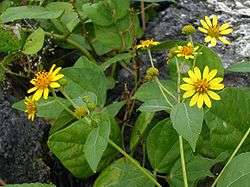Melanthera
Melanthera, squarestem,[5] is a genus of flowering plants in the daisy family, Asteraceae, native to North and South America, as well as Africa, Asia and Oceania, including Hawaiʻi.[6][7][8][9][10]
| Melanthera | |
|---|---|
 | |
| Melanthera biflora (L.) Wild | |
| Scientific classification | |
| Kingdom: | |
| (unranked): | |
| (unranked): | |
| (unranked): | |
| Order: | |
| Family: | |
| Subfamily: | |
| Tribe: | |
| Genus: | Melanthera Rohr[3] |
| Synonyms[1] | |
| |
The generic name means "black anther."[11]
The most common species of this genus is Melanthera biflora, found in the coastal areas and islands of the tropical belt of the Indo-Pacific region.[12] Together with Portulaca oleracea, Ipomoea pes-caprae and Digitaria ciliaris, Melanthera biflora is usually one of the first species colonizing degraded or altered environments in tropical zones of the planet.[13]
Despite their general hardiness, leaves of Melanthera species are often attacked by rusts such as Uromyces columbianus and Uromyces martinii.[14]
Taxonomy
There are difficulties regarding the classification of this genus for its affinities are uncertain. Further studies are needed to clarify its taxonomic and phylogenetic relationships.[15][16]
Species
This is a list of species.[1][17]
- Melanthera abyssinica (Sch.Bip. ex A.Rich.) Vatke - tropical Africa from Ethiopia to Tanzania + Sierra Leone
- Melanthera angustifolia A.Rich. - Central America, Cuba, Yucatán, Bahamas, southern Florida
- Melanthera biflora (L.) Wild. Indo-Pacific
- Melanthera bryanii (Sherff) W.L.Wagner & H.Rob. – Pili Nehe; Hawaiʻi
- Melanthera buchii Urb. - Haiti
- Melanthera cinerea Schweinf. ex Schweinf. - Africa
- Melanthera discoidea S.F.Blake - Amazonas State in Brazil
- Melanthera elliptica O.Hoffm. - central Africa
- Melanthera fauriei (H. Lév.) W.L.Wagner & H.Rob. – Olokele Canyon Nehe; Hawaiʻi
- Melanthera felicis C.D.Adams - Guinea in West Africa
- Melanthera gambica Hutch. & Dalziel - Gambia, Senegal, Guinea-Bissau in West Africa
- Melanthera hastata (Walt.) Rich. - Michoacán in Mexico, Islas de la Bahía in Honduras, Bahamas, El Salvador
- Melanthera integrifolia (Nutt.) W.L.Wagner & H.Rob. – Kure Atoll Nehe; Hawaiʻi
- Melanthera kamolensis (O.Deg.) & Sherff) W.L.Wagner & H.Rob. – Maui Nehe; Mauʻi
- Melanthera latifolia (Gardner) Cabrera - Brazil, Bolivia, Paraguay, Uruguay, Argentina
- Melanthera lavarum (Gaudich.) W.L. Wagner & H.Rob. – Coastal Nehe; Hawaiʻi.
- Melanthera micrantha (Nutt.) W.L.Wagner & H.Rob. - Hawaiʻi
- Melanthera nivea (L.) Small – Pineland Squarestem, Snow Squarestem, Yerba de Cabra; SE United States (LA MS AL GA FL SC TN KY IL),[18] Caribbean, Mexico (from Tamaulipas to Quintana Roo), Central America, South America (Colombia, Venezuela, Ecuador, Guianas, northern Brazil)
- Melanthera parvifolia Small – Small-leaf Squarestem - southern Florida
- Melanthera perdita (Sherff) W.L.Wagner & H.Rob. – Koʻokoʻolau; Hawaiʻi
- Melanthera populifolia (Sherff) W.L. Wagner & H.Rob. – Grassland Nehe; Hawaiʻi
- Melanthera prostrata (Hemsl.) W.L.Wagner & H.Rob. - China, Japan, Korea, Thailand, Vietnam[19]
- Melanthera pungens Oliv. & Hiern - tropical Africa
- Melanthera remyi (A.Gray) W.L.Wagner & H.Rob. – Annual Nehe; Hawaiʻi
- Melanthera scandens (Schumach.) Roberty[20]
- Melanthera rhombifolia O.Hoffm. & Muschl. - West Africa
- Melanthera richardsae Wild - tropical Africa
- Melanthera robinsonii Wild - tropical Africa
- Melanthera robusta (Makino) K.Ohashi & H.Ohashi - Japan, Taiwan
- Melanthera scaberrima Hiern - Angola
- Melanthera scandens (Schumach. & Thonn.) Roberty - tropical Africa
- Melanthera subcordata (A.Gray) W.L.Wagner & H.Rob. - Hawaiʻi
- Melanthera tenuifolia (A.Gray) W.L.Wagner & H.Rob. – Waianae Range Nehe; Oʻahu
- Melanthera tenuis (O.Deg. & Sherff) W.L.Wagner & H.Rob. – Streambed Nehe; Hawaiʻi
- Melanthera triternata (Klatt) Wild - southern Africa
- Melanthera venosa (Sherff) W.L. Wagner & H.Rob. – Spreading Nehe; Hawaiʻi
- Melanthera waimeaensis (H.St.John) W.L. Wagner & H.Rob. – Waimea Canyon Nehe; Kauaʻi
References
- Flann, C (ed) 2009+ Global Compositae Checklist Archived 2014-11-06 at Archive.today
- "Genus Melanthera". Taxonomy. UniProt. Retrieved 2011-02-14.
- "Genus: Melanthera Rohr". Germplasm Resources Information Network. United States Department of Agriculture. 1996-09-17. Archived from the original on 2015-06-18. Retrieved 2011-02-14.
- "GRIN - Genus: Wollastonia DC. ex Decne". Archived from the original on 2015-06-18. Retrieved 2015-06-18.
- "Melanthera". Natural Resources Conservation Service PLANTS Database. USDA. Retrieved 30 June 2015.
- Rohr, Julius Philip Benjamin von. 1792. Skrifter af Naturhistorie-Selskabet 2(1): 213–214
- Davidse, G., M. Sousa-Peña, S. Knapp & F. Chiang Cabrera. 2015. Asteraceae. 5(2): ined. In G. Davidse, M. Sousa Sánchez, S. Knapp & F. Chiang Cabrera (eds.) Flora Mesoamericana. Universidad Nacional Autónoma de México, México D.F..
- Parks, J. C. 1973. A revision of North American and Caribbean Melanthera (Compositae). Rhodora 75: 169–210.
- Pruski, J.F. 1997. Asteraceae. 3: 177–393. In J. A. Steyermark, P. E. Berry & B. K. Holst (eds.) Flora of the Venezuelan Guayana. Missouri Botanical Garden Press, St. Louis
- Wild, H. 1965. The African species of the genus Melanthera Rohr. Kirkia 5: 1–17
- Flora of North America Vol. 21 Page 123 Melanthera Rohr, Skr. Naturhist.-Selsk. 2: 213. 1792.
- Response of Melanthera biflora to Salinity and Water Stress
- Heatwole, H., Done, T., Cameron, E. Community Ecology of a Coral Cay, A Study of One-Tree Island, Great Barrier Reef, Australia. Series: Monographiae Biologicae, Vol. 43, p. 102
- George Baker Cummins (1978). Rust Fungi on Legumes and Composites in North America. Tucson: University of Arizona Press. ISBN 0-8165-0653-1.
- Phylogenetic relationships of subtribe Ecliptinae - American Journal of Botany
- Orchard, Anthony E. 2013. The Wollastonia/Melanthera/Wedelia generic concept (Asteraceae:Ecliptinae), with particular reference to Australia and Malesia. Nuytsia 23:337-466 (as Acunniana procumbens (DC.) Orchard),
- "Melanthera". Integrated Taxonomic Information System. Retrieved 2011-02-14.
- Biota of North America Program, 2013 county distribution map
- Flora of China, Vol. 20-21 Page 871 卤地菊 lu di ju Melanthera prostrata (Hemsley) W. L. Wagner & H. Robinson, Brittonia. 53: 557. 2002.
- "GRIN Species Records of Melanthera". Germplasm Resources Information Network. United States Department of Agriculture. Archived from the original on 2015-09-24. Retrieved 2011-02-14.
External links

